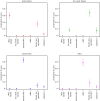Still 'dairy farm fever'? A Bayesian model for leptospirosis notification data in New Zealand
- PMID: 33593210
- PMCID: PMC8086863
- DOI: 10.1098/rsif.2020.0964
Still 'dairy farm fever'? A Bayesian model for leptospirosis notification data in New Zealand
Abstract
Routinely collected public health surveillance data are often partially complete, yet remain a useful source by which to monitor incidence and track progress during disease intervention. In the 1970s, leptospirosis in New Zealand (NZ) was known as 'dairy farm fever' and the disease was frequently associated with serovars Hardjo and Pomona. To reduce infection, interventions such as vaccination of dairy cattle with these two serovars was implemented. These interventions have been associated with significant reduction in leptospirosis incidence, however, livestock-based occupations continue to predominate notifications. In recent years, diagnosis is increasingly made by nucleic acid detection which currently does not provide serovar information. Serovar information can assist in linking the recognized maintenance host, such as livestock and wildlife, to infecting serovars in human cases which can feed back into the design of intervention strategies. In this study, confirmed and probable leptospirosis notification data from 1 January 1999 to 31 December 2016 were used to build a model to impute the number of cases from different occupational groups based on serovar and month of occurrence. We imputed missing occupation and serovar data within a Bayesian framework assuming a Poisson process for the occurrence of notified cases. The dataset contained 1430 notified cases, of which 927 had a specific occupation (181 dairy farmers, 45 dry stock farmers, 454 meatworkers, 247 other) while the remaining 503 had non-specified occupations. Of the 1430 cases, 1036 had specified serovars (231 Ballum, 460 Hardjo, 249 Pomona, 96 Tarassovi) while the remaining 394 had an unknown serovar. Thus, 47% (674/1430) of observations had both a serovar and a specific occupation. The results show that although all occupations have some degree of under-reporting, dry stock farmers were most strongly affected and were inferred to contribute as many cases as dairy farmers to the burden of disease, despite dairy farmer being recorded much more frequently. Rather than discard records with some missingness, we have illustrated how mathematical modelling can be used to leverage information from these partially complete cases. Our finding provides important evidence for reassessing the current minimal use of animal vaccinations in dry stock. Improving the capture of specific farming type in case report forms is an important next step.
Keywords: Markov chain Monte Carlo; data imputation; epidemiology; leptospirosis.
Figures






Similar articles
-
Emerging Leptospira strain poses public health risk for dairy farmers in New Zealand.Prev Vet Med. 2019 Oct 1;170:104727. doi: 10.1016/j.prevetmed.2019.104727. Epub 2019 Jul 4. Prev Vet Med. 2019. PMID: 31421493
-
Diverse Epidemiology of Leptospira serovars Notified in New Zealand, 1999-2017.Pathogens. 2020 Oct 14;9(10):841. doi: 10.3390/pathogens9100841. Pathogens. 2020. PMID: 33066613 Free PMC article.
-
A cluster of three cases of leptospirosis in dairy farm workers in New Zealand.N Z Med J. 2014 Jan 24;127(1388):13-20. N Z Med J. 2014. PMID: 24481382 Review.
-
Molecular typing of Leptospira spp. in farmed and wild mammals reveals new host-serovar associations in New Zealand.N Z Vet J. 2024 Jan;72(1):1-9. doi: 10.1080/00480169.2023.2248930. Epub 2023 Sep 3. N Z Vet J. 2024. PMID: 37589061
-
Leptospirosis in farmed deer in New Zealand : a review.N Z Vet J. 2007 Jun;55(3):102-8. doi: 10.1080/00480169.2007.36750. N Z Vet J. 2007. PMID: 17534410 Review.
Cited by
-
A cross-sectional investigation of Leptospira at the wildlife-livestock interface in New Zealand.PLoS Negl Trop Dis. 2023 Sep 6;17(9):e0011624. doi: 10.1371/journal.pntd.0011624. eCollection 2023 Sep. PLoS Negl Trop Dis. 2023. PMID: 37672535 Free PMC article.
-
"We don't really do doctors." messages from people diagnosed with occupational leptospirosis for medical professionals on infection, hospitalisation, and long-term effects.Heliyon. 2023 Aug 22;9(9):e19303. doi: 10.1016/j.heliyon.2023.e19303. eCollection 2023 Sep. Heliyon. 2023. PMID: 37674827 Free PMC article.
-
Longitudinal Testing of Leptospira Antibodies in Horses Located near a Leptospirosis Outbreak in Alpacas.Vet Sci. 2022 Aug 12;9(8):426. doi: 10.3390/vetsci9080426. Vet Sci. 2022. PMID: 36006341 Free PMC article.
-
Case-control study of leptospirosis in Aotearoa New Zealand reveals behavioural, occupational, and environmental risk factors.Epidemiol Infect. 2025 Jun 2;153:e67. doi: 10.1017/S0950268825100071. Epidemiol Infect. 2025. PMID: 40452512 Free PMC article.
-
Leptospirosis in Aotearoa New Zealand: Protocol for a Nationwide Case-Control Study.JMIR Res Protoc. 2023 Jun 8;12:e47900. doi: 10.2196/47900. JMIR Res Protoc. 2023. PMID: 37289491 Free PMC article.
References
Publication types
MeSH terms
Substances
Grants and funding
LinkOut - more resources
Full Text Sources
Other Literature Sources

